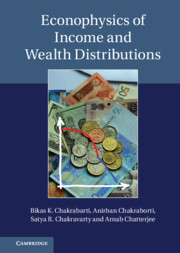Book contents
- Frontmatter
- Contents
- Preface
- 1 Introduction
- 2 Income and wealth distribution data for different countries
- 3 Major socioeconomic modelling
- 4 Market exchanges and scattering process
- 5 Analytic structure of the kinetic exchange market models
- 6 Microeconomic foundation of the kinetic exchange models
- 7 Dynamics: generation of income, inequality and development
- 8 Outlook
- References
- Index
2 - Income and wealth distribution data for different countries
Published online by Cambridge University Press: 05 May 2013
- Frontmatter
- Contents
- Preface
- 1 Introduction
- 2 Income and wealth distribution data for different countries
- 3 Major socioeconomic modelling
- 4 Market exchanges and scattering process
- 5 Analytic structure of the kinetic exchange market models
- 6 Microeconomic foundation of the kinetic exchange models
- 7 Dynamics: generation of income, inequality and development
- 8 Outlook
- References
- Index
Summary
Investigations over more than a century and the recent availability of electronic databases of income and wealth distribution (ranging from a national sample survey of household assets to the income tax return data available from governmental agencies) have revealed some remarkable features. Irrespective of many differences in culture, history, social structure, indicators of relative prosperity (such as gross domestic product or infant mortality) and, to some extent, the economic policies followed in different countries, the income distribution seems to follow a particular universal pattern, as does the wealth distribution: after an initial rise, the number density of people rapidly decays with their income, the bulk described by a Gibbs or log-normal distribution crossing over at the very high income range (for 5–10% of the richest members of the population) to a power law, as shown in Fig. 1.1. The power law in income and wealth distribution is called the Pareto law, after the Italian sociologist and economist Vilfredo Pareto. The log-normal part is named as the Gibrat law, after the French economist Robert Gibrat. This seems to be a universal feature: from ancient Egyptian society (Abul-Magd 2002) through nineteenth-century Europe (Pareto 1897; Champernowne 1953) to modern Japan (Chatterjee et al. 2005b; Chakrabarti et al. 2006). The same is true across the globe today: from the advanced capitalist economy of USA (Chatterjee et al. 2005b; Kar Gupta 2006a; Richmond et al. 2006) to the developing economy of India (Sinha 2006).
- Type
- Chapter
- Information
- Econophysics of Income and Wealth Distributions , pp. 7 - 34Publisher: Cambridge University PressPrint publication year: 2013



